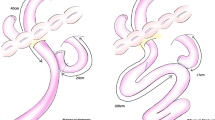Abstract
Refractory esophageal ulcerations occur rarely after cardiovascular surgery, occasionally leading to perforation. There is little consensus on their optimal management. Herein, we present a case of refractory esophageal ulceration after cardiovascular surgery. A 62-year-old woman with Marfan’s syndrome was referred to our hospital with cardiac failure due to aortic regurgitation. She underwent root replacement by the modified Bentall method. Refractory esophageal ulceration developed 3 months later and persisted for 3 months despite conservative therapy. With the patient’s informed consent, Kirschner bypass surgery was performed. A jejunostomy using a 20 Fr. Nelaton catheter was made in the Roux-en-Y loop of the jejunum for postoperative endoscopy. The postoperative course was uneventful and transjejunostomal endoscopy revealed excellent healing of the ulceration. Esophageal bypass surgery and transjejunostomal endoscopy were very effective in this patient with refractory esophageal ulceration.




Similar content being viewed by others
References
Guillem PG, Porte HL, Saudemont A, Quandalle PA, Wurtz AJ. Perforation of Barrett’s ulcer: a challenge in esophageal surgery. Ann Thorac Surg. 2000;69:1707–10.
Nigro JJ, Bremner RM, Fuller CB, Theisen J, Ma Y, Starnes VA. Perforating Barrett’s ulcer resulting in a life-threatening esophagobronchial fistula. Ann Thorac Surg. 2002;73:302–4.
Guillem P, Porte H, Techer E, Wurtz A. Aortoesophageal fistula of uncommon origin: perforation of a Barrett’s ulcer. Dis Esophagus. 2003;16:259–60.
Eggebrecht H, Mehta RH, Dechene A, Tsagakis K, Kuhl H, Huptas S, Gerken G, Jakob HG, Erbel R. Aortoesophageal fistula after thoracic aortic stent-graft placement: a rare but catastrophic complication of a novel emerging technique. JACC Cardiovasc Interv. 2009;2:570–6.
Chan YC, Ting AC, Law S, Cheng SW. Secondary infection of a pre-existing thoracic aortic aneurysm by iatrogenic oesophageal perforation with aorta-oesophageal fistula formation. Eur J Cardiothorac Surg. 2009;35:365–7.
Czerny M, Zimpfer D, Fleck T, Gottardi R, Cejna M, Schoder M, Lammer J, Wolner E, Grabenwoger M, Mueller MR. Successful treatment of an aortoesophageal fistula after emergency endovascular thoracic aortic stent-graft placement. Ann Thorac Surg. 2005;80:1117–20.
Chandrashekar G, Kumar VMN, Kumar AK. Repair of aortoesophageal fistula due to a penetrating atherosclerotic ulcer of the descending thoracic aorta and literature review. J Cardiothorac Surg. 2007;2:12.
Whooley BP, Law S, Murthy SC, Alexandrou A, Chu KM, Wong J. The Kirschner operation in unresectable esophageal cancer: current application. Arch Surg. 2002;137:1228–32.
Kijima M, Kubo H, Iwabuchi S, Anan A, Nagao F. Restricted indication for an esophageal bypass operation as suggested through the authors experience and study. Med J. 1987;34:405–16.
Mannell A. The Kirschner operation for cancer of the oesophagus. Ann R Coll Surg Engl. 1982;64:256–9.
Roeher HD, Horeyseck G. The Kirschner bypass operation—a palliation for complicated esophageal carcinoma. World J Surg. 1981;5:543–6.
Postlethwait RW. Technique for isoperistaltic gastric tube for esophageal bypass. Ann Surg. 1979;189:673–6.
Heimlich HJ. Esophagitis Complications treated by total bypass without esophageal resection. Ann Thorac Surg. 1970;10:203–12.
Cseke L, Horvath OP. Indications, new surgical technique and results of colon interposition or bypass in esophageal surgery. Acta Chir Hung. 1997;36:49–50.
DeMeester TR, Johansson KE, Franze I, Eypasch E, Lu CT, McGill JE, Zaninotto G. Indication, surgical technique, and long-term functional results of colon interposition or bypass. Ann Surg. 1988;208:460–74.
Yamagishi M. An isoperistaltic gastric tube; new method of esophageal replacement. Arch Surg. 1970;100:689–92.
Nakamura T, Yoshida M, Kitagawa Y, Jin L, Ishikawa H, Kameyama K, Wakabayashi G, Tanabe M, Kawachi S, Shinoda M, Saikawa Y, Wada N, Kubota T, Kumai K, Sano K, Kitajima M. Intravenous injection of micafungin counteracts Candida albicans-induced aggravation of duodenal ulcers caused by cysteamine in rats. Dig Dis Sci. 2008;53:2422–8.
Jin L, Yoshida M, Nakamura T, Ishikawa H, Wakabayashi G, Tanabe M, Kawachi S, Shinoda M, Saikawa Y, Wada N, Kameyama K, Kumai K, Kubota T, Sano K, Nagao K, Amagai M, Kitagawa Y, Kitajima M. Candida albicans infection delays duodenal ulcer healing in cysteamine-induced duodenal ulcers in rats. Dig Dis Sci. 2008;53:2878–85.
Nakamura T, Yoshida M, Ishikawa H, Kameyama K, Wakabayashi G, Otani Y, Shimazu M, Tanabe M, Kawachi S, Kumai K, Kubota T, Saikawa Y, Sano K, Kitajima M. Candida albicans sggravates duodenal ulcer perforation induced by administration of cysteamine in rats. J Gastroenterol Hepatol. 2007;22:749–56.
Ishiguro T, Takayanagi N, Ikeya T, Yoshikawa H, Yanagisawa T, Hoshi E, Hoshi T, Sugita Y, Kawabata Y. Isolation of Candida species is an important clue for suspecting gastrointestinal tract perforation as a cause of empyema. Inter Med. 2010;49:1957–64.
Ethical Statement
We declare that the present manuscript is in accordance with the ethical standards of the responsible committee on human experimentation (institutional) and with the Helsinki Declaration of 1975, as revised in 2008, and that informed consent for publication of this case report was obtained from the relevant patient.
Conflict of interest
There are no financial or other relations that could lead to a conflict of interest.
Author information
Authors and Affiliations
Corresponding author
Rights and permissions
About this article
Cite this article
Kubota, K., Okada, A., Kuroda, J. et al. Utility of transjejunostomal endoscopy following bypass surgery for refractory esophageal ulceration after thoracic aortic aneurysm operation in a patient with Marfan’s syndrome. Esophagus 12, 73–76 (2015). https://doi.org/10.1007/s10388-013-0406-4
Received:
Accepted:
Published:
Issue Date:
DOI: https://doi.org/10.1007/s10388-013-0406-4




